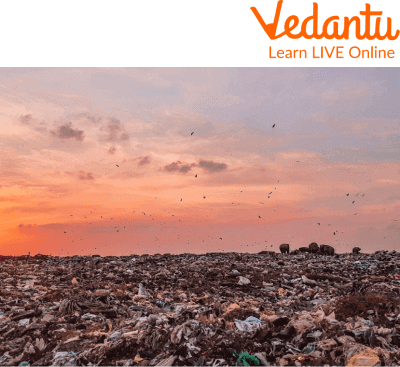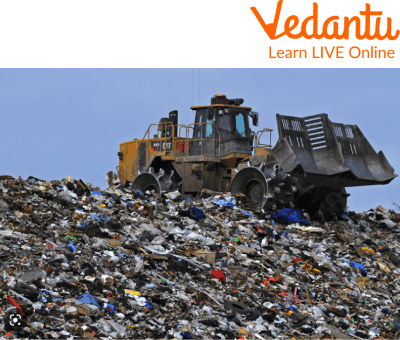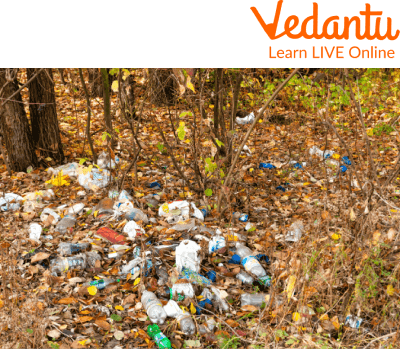




What Is Land Pollution? Causes, Effects & How Kids Can Help
Have you ever seen any bag of vegetable peels littered on the ground while taking an evening stroll? Or have you noticed an overflowing garbage dumpster in your area? You might have definitely seen people throwing wrappers here and there in parks, roads or in any public space. Any such undesirable change in the physical, chemical or biological properties of the land, which has an effect on humans and other organisms or which destroys the quality and use of the land, is called land pollution. These days, land pollution is an international problem.
Our land is harmed and contaminated by these needless items. You have probably observed unclean streets with garbage lying around. This garbage contributes to land pollution as well. Let’s now see more about land pollution and the causes of land pollution for kids.

Land Pollution
Land Pollution
Garbage, plastic bags, rotten vegetables by the side of the road is frequently what comes to mind when we first think about pollution. Land pollution is the name for this kind of contamination. Anything that harms or contaminates the land is referred to as land pollution.
What is Land Pollution?
The degradation (destruction) of the earth's land surfaces is known as "land pollution," and it frequently results either directly or indirectly from human activity and the abuse of land resources. Land pollution refers to the discharge of toxic, unwanted and unusable substances into the land because it leads to land degradation and affects the quality of the soil. Due to the irresponsibility of people, the earth is getting polluted. Here are some examples of land pollution: garbage on every corner or the side of the road, oil spills, illegal dumping in natural habitats, etc.
Causes of Land Pollution for Kids
Some important causes of land pollution are as follows:
Garbage: The household's waste product is garbage. By 2010, the United States produced almost 250 million tons of waste. This indicates that each person was generating 2 Kg of garbage each day. So, where will this garbage go? These waste materials most likely require some type of site where they can be dumped. The location where garbage is disposed of is known as a landfill. These landfills encroach on unclaimed land and create numerous issues.
Factories: Waste products are produced worldwide by all factories. These waste materials may include dangerous substances that can seriously harm the environment. There are laws governing how to properly dispose of chemical waste in many developed nations. In India, despite numerous rules, manufacturing and drainage waste is dumped in rivers.
Farming: To meet our food needs, wheat, rice, fruits, and vegetables are farmed. To cultivate crops, farming requires unoccupied land. To do this, forests are cut down to make more space for farming. Additionally, chemical fertilisers and pesticides are utilised to increase agricultural productivity. These substances also harm the area's soil and water resources.
Mining: The process of mining is used to extract minerals and coal from the earth. Land erosion is a side effect of the holes that are dug during mining. Additionally, the air and soil are contaminated by the toxic chemicals and gases released from mines.

Causes of Land Pollution
Effects of Land Pollution
Land pollution harms the earth in a variety of ways. Let us go through the numerous affected spheres by land pollution:
1. Effect on Humans
Our environment is harmed by land contamination, which is exceedingly damaging to all living beings. Numerous illnesses, including cancer and skin infections, can be brought on by increased soil pollution.
2. Effects on Agriculture
Pollutants frequently soak into the soil and combine with the subsurface groundwater. This is then taken by crops. These crops are the ones which we eat.
3. Effect on Global Warming
The waste is disposed of by burying it in the ground in landfills. The effect is harm to the nearby land. Additionally, landfills emit methane gas, which intensifies the impact of global warming.

Effects of Land Pollution
Summary
To conclude all the conceptual understanding regarding land pollution, we saw the magnitude and breadth of this pollution, which first affects the soil profile and then travels to distant locations like aquatic bodies through the groundwater system. The proper disposal of waste material will help to minimise land pollution and would help to keep our surrounding healthy. We hope you enjoyed reading this article and learnt something new.
FAQs on Land Pollution for Kids: Simple Guide with Examples
1. What are the three primary classifications of pollution?
The three basic categories of pollution, air, water, and land are frequently divided according to the environment. Particulate pollutants, like plastic, light, and noise pollution, are also of concern to contemporary civilization.
2. How to reduce/prevent land pollution?
The following are a few ways to prevent land pollution:
Prohibition on the use of toxic drugs sprayed on crops.
Proper places to collect dirt in villages and cities.
Proper arrangement of water in the fields.
Use of traditional manure in place of artificial fertilisers.
Ban the destruction of forests.
Recycling and reusing industrial and household waste can significantly reduce soil pollution.
Limit the emissions from your car.
Reduce the amount of material stuff you consume.
Make use of renewable energy.
Recycle as much as possible. Reduce the use of plastic.
Encourage your government to preserve forest areas.
3. What is the main source of land pollution?
A few sources of land pollution are as follows:
(i) Industrial Wastes: A large number of industrial chemicals, dyes, acids, fertiliser companies, pharmaceutical companies, etc. find their way into the soil and are known to create many health hazards including cancer.
(ii) Urban Waste: Due to modern lifestyles and food habits, urban waste is becoming very dangerous for human beings. Urban waste includes both those materials which are harmful and harmful to society in the long run.
(iii) Agricultural Sources: The soil is polluted by agricultural chemicals, particularly fertilisers and pesticides. Fertilisers released from the waters of these areas can cause eutrophication in water bodies.









